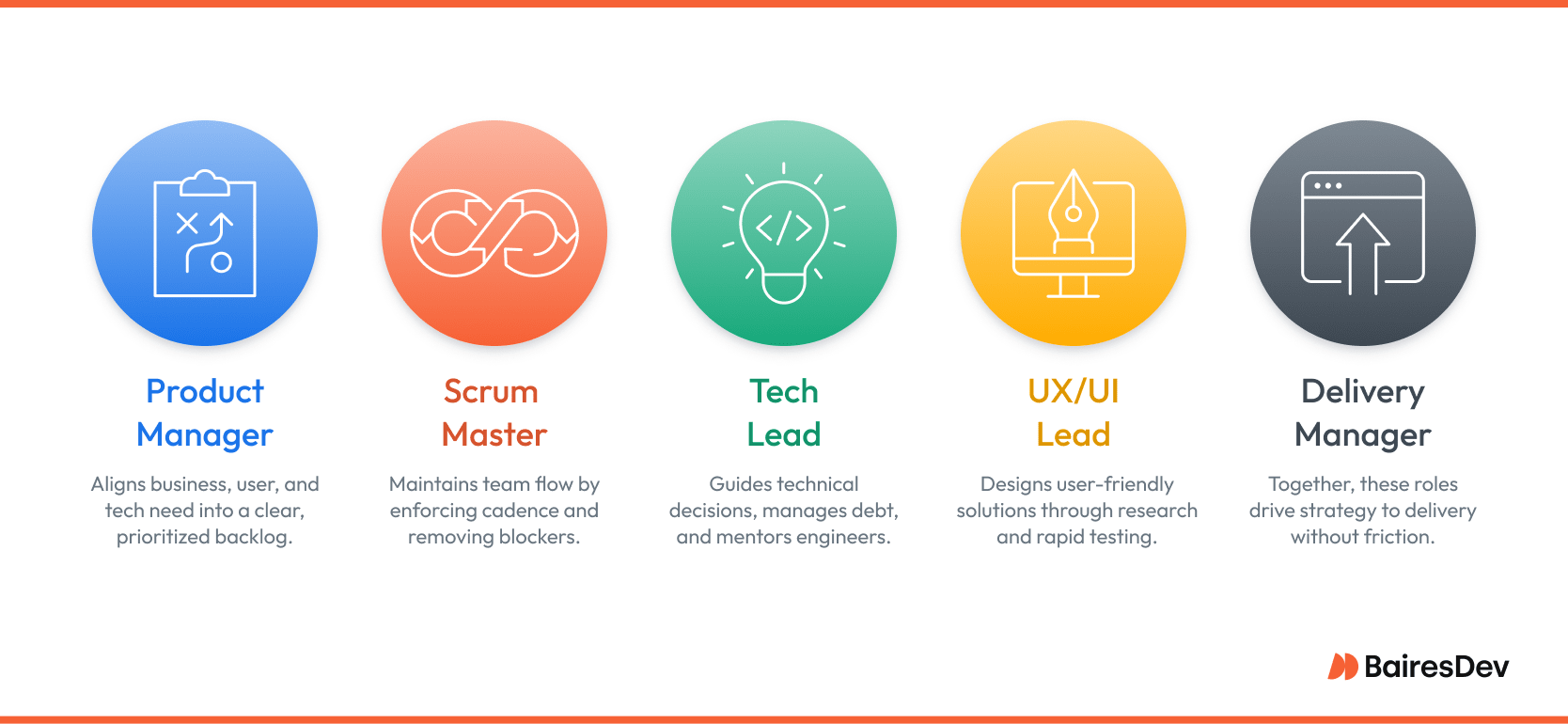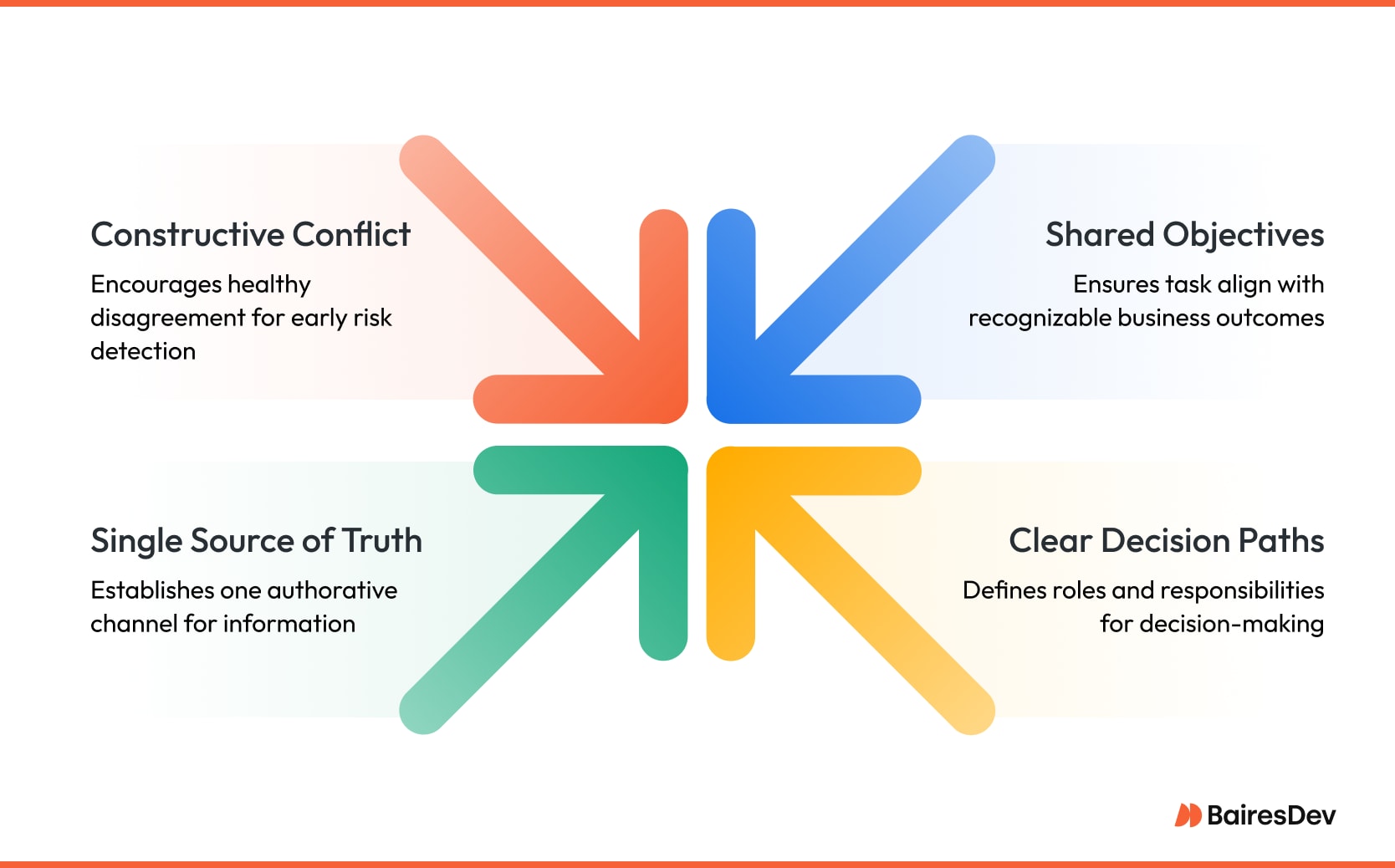Cross-functional teams are built to solve one problem. Too many handoffs across too many roles slow everything down. Instead of bouncing work between departments, a cross-functional team owns the entire delivery cycle. Engineers, designers, product leads, and delivery managers work in sync, not in sequence.
This structure only works if the team is senior, the process is real, and the goals are shared. When those conditions hold, output improves. Code ships faster. Feedback loops shrink. Delays stop being systemic.
Done poorly, it becomes another committee. Done well, it replaces layers of overhead with one accountable unit that ships.
The Operating Model Behind Cross-Functional Teams
Most delivery problems are coordination problems. Cross-functional teams solve this by replacing fragmented workflows with shared ownership. Instead of handing off tasks between functions, the team works as a single unit with aligned priorities and clear accountability.
When built correctly, these teams collapse silos, reduce context switching, and shorten the path between idea and execution. Engineers, designers, and product leaders work side by side. Communication improves. Decisions get made faster. Delivery accelerates.
What Cross-Functional Teams Actually Solve
Most enterprise software failures don’t come from bad ideas or weak talent. They come from coordination gaps. Teams operate in isolation. Priorities drift. Delivery slows to a crawl. Cross-functional teams are designed to fix that.
By bringing engineers, designers, product owners, and delivery managers into one group, they collapse the layers that typically create delays. There’s no waiting on external teams. No handoffs. No retranslation of requirements. Just a single, accountable unit moving in sync.
This model is especially effective when systems are fragmented or delivery velocity is blocked by too many internal dependencies. If your architecture is growing faster than your org can manage it, this is the model that restores control.
What a Cross-Functional Team Looks Like
A successful cross-functional team is not just a mixed group of specialists, team members with different skills and backgrounds. It’s a delivery unit with end-to-end responsibility. That includes scoping, development, design, testing, iteration, and rollout. Everyone on the team shares accountability for what gets shipped and when.
These teams are often built around Agile delivery principles, with defined sprints, clear roles, and regular feedback cycles. The entire team operates on a single backlog and move together from planning to production.
In practice, this might include a team leader, a senior engineer or tech lead, a product owner, a designer, a QA lead, and a delivery manager. The structure scales with complexity, but the principle stays the same. Fewer walls. Fewer delays. Better software.
How They Operate: Agile, Accountability, and Speed
Cross-functional collaboration relies on Agile not as a formality but as a control system. Agile breaks down delivery into focused sprints, committing teams to shorter planning cycles, and the use of clear metrics to track progress. The point isn’t ceremony. It’s velocity with accountability.
Every member of the team contributes to the same backlog: project managers, engineers, marketing managers. Work is reviewed continuously. Priorities shift based on real feedback, not static plans. Instead of waiting on external approvals or disconnected roadmaps, the team adjusts in real time to meet specific project goals.
A typical team runs biweekly sprints with demos, retros, and daily standups. The Scrum Master enforces discipline, but the team owns the process. If a blocker emerges, it’s resolved in an efficient manner, internally, or escalated quickly. Product decisions stay close to the build process. Engineers are involved early. QA runs alongside dev, not behind it.
Burndown charts, velocity trends, and story completion rates provide visibility and break down functional silos, but the deeper value comes from shared ownership. Nobody is “waiting on other teams.” The work is the team’s responsibility, start to finish, and this promotes cohesion.
This model scales well when done right. It can handle complex systems and shifting requirements without losing momentum. But it depends on maturity. Without experienced leads and real Agile fluency, it becomes just another structure with new labels.
Key Roles and Their Functions
A cross functional team only moves as fast as its leadership spine. Each role must bring clear authority, sharp judgment, and visible accountability. The five functions below form that spine. Together they convert strategy into delivery without the drag of handoffs or conflicting incentives.

Product Manager
The product manager owns the problem statement. This role aligns business goals, user needs, and technical reality, then converts that alignment into a single backlog. A strong product manager speaks both finance and engineering, and constantly collaborates with different departments. They translate revenue targets into feature priorities, work on GTM strategies with the marketing team, write acceptance criteria, and shield delivery from random executive requests. For a vice president of engineering, the product manager is a strategic ally. When scope or timeline drifts, this is the person who recalibrates expectations with data rather than opinion.
Scrum Master
The scrum master protects flow. They enforce cadence, facilitate retrospectives, and remove blockers before they stall a sprint. In mature settings the role is not a meeting scheduler but an operational analyst. They track velocity trends, surface systemic impediments, and coach the team on empirical planning. A seasoned scrum master gives senior leadership early warning when capacity mismatches demand trade offs, which prevents ugly surprises at release time.
Tech Lead
The tech lead is the engineering authority inside the team. Design patterns, stack selection, code review standards, and security posture all route through this person. They think several sprints ahead, ensuring that today’s shortcut does not become next quarter’s incident. For executives concerned with risk, the tech lead is the assurance layer. They keep technical debt visible, arbitrate architectural debates quickly, and mentor mid level engineers so productivity scales without constant hiring.
UX/UI Lead
Quality software fails if users cannot navigate it. The UX UI lead anchors the human side of the product. They gather research, craft interaction models, and run rapid tests that uncover friction before it reaches production. Their deliverables—wireframes, prototypes, design systems—cut iteration loops in half because engineers build on validated assumptions. For a chief product officer, the UX UI lead provides the evidence needed to justify design decisions during budget reviews and stakeholder demos.
Delivery Manager
The delivery manager handles external alignment. They report progress, manage scope agreements, and keep procurement, security, and compliance teams in the loop. Internally, they coordinate release logistics so that handover to operations is smooth.
In enterprise environments this role absorbs the noise that would otherwise distract the core builders. When board level updates or audit questions appear, the delivery manager gathers the metrics, arranges demos, and ensures the narrative remains consistent across functions.
When these five roles operate with clear boundaries and shared metrics, a cross functional team becomes a single accountable unit from concept to production. Remove any one role and blind spots appear. Strengthen all five and delivery accelerates without sacrificing quality or governance.
Ground Rules for Team Success
Every high-performing cross functional team starts with a compact set of rules that everyone can quote from memory. Keep it simple!
These rules shape daily behaviour, guide conflict resolution, and keep the sprint on tempo when pressure rises. Think of them as the operating contract that replaces layers of policy and email chains.

Shared Objectives
Each backlog item must map to a business outcome that a stakeholder can recognise. If an engineer cannot explain why a task matters, it waits outside the sprint until the value is clear.
Clear Decision Paths
The product manager sets scope, the tech lead owns architecture, and the delivery manager controls release logistics. When an issue lives between roles the team resolves it in the next stand-up, not in a private chat that leaves half the group guessing.
Single Source of Truth
Whether the team uses Jira comments, a Git repo, or Slack threads, one channel is marked authoritative. Status never lives in two places. This rule eliminates version control on conversations.
Constructive Conflict
Disagreement is welcome because it surfaces risk early. Personal friction is not. The scrum master enforces effective communication by ensuring every voice is heard inside a strict time box.
After a few iterations these ground rules disappear into habit, freeing the team to focus on shipping rather than negotiating etiquette.
What Success Looks Like
An executive does not measure a cross-functional team by enthusiasm. Success shows up in numbers that survive a finance review and a postmortem. Five metrics cover the essentials:
Lead time for change tracks the calendar days from idea to production. Lower is better because value reaches users sooner.
Sprint predictability compares committed story points with completed work. A ratio above ninety percent suggests sound estimation and healthy flow.
Escaped defects count bugs that slip past testing. The trend should move down quarter over quarter.
Cycle efficiency measures the share of active engineering time versus wait states. The percentage climbs as handoffs disappear.
Team sentiment applies a lightweight pulse survey that spot checks engagement and burnout. A technical team that dreads each stand-up will not hold velocity for long.
Those numbers demand context. A five percent rise in lead time might be acceptable if the team absorbed an urgent security overhaul. Pair the raw data with a narrative so leadership can see cause and effect, not just green and red arrows.
Common Pitfalls and How to Avoid Them
Even seasoned teams stumble when subtle issues go unchallenged. The list below is not exhaustive, yet it covers the traps that surface most often in large enterprises.
- Role Drift: Boundary lines blur, the tech lead starts rewriting the roadmap, and engineers bypass code review to meet a date. The fix is visible ownership. Publish a responsibility matrix on the team wiki and revisit it any time someone asks, “who decides this?”
- Hidden Dependencies: A sprint appears clean until an external security review blocks deployment. Map every dependency during planning, tag the risk level, and set alerts well before the blocker’s due date.
- Velocity Worship: Story points become vanity metrics. Delivery accelerates in numbers yet adds fragile features that customers ignore. Balance velocity with a customer impact measure, for example adoption rate or revenue lift.
- Feedback Without Action: Retrospectives feel cathartic, but nothing changes. Assign a clear owner and completion date to each action item, and track closure at the next retro. No carryover, no excuses.
- Tool Sprawl: Multiple boards, chat rooms, and document stores fracture attention. Consolidate or integrate. Every extra tool creates a fresh seam for misalignment.
By tackling these pitfalls early the team preserves momentum and credibility with stakeholders who care less about process labels and more about reliable delivery.
Measuring Team Success
Dashboards tell part of the story; qualitative signals fill the gaps. A mature measurement cadence layers both views.
Sprint Reports originate from the work tracking system. They highlight throughput, defects, and blockers in plain language. Executives can scan them in minutes.
Release Postmortems dig into each production push. The team meets within forty-eight hours, lists what worked, what failed, and what to change next time. Findings produce backlog items, not abstract lessons.
Stakeholder Surveys capture satisfaction from adjacent cross-functional groups, including security, customer support, and finance. High ratings confirm smooth collaboration; low scores trigger immediate follow-up.
Customer Outcomes connect features to adoption curves, support ticket volume, and, when possible, revenue impact. Finance leaders appreciate a direct line from backlog item to balance sheet.
Blending data with narrative builds trust. Leaders see the team course-correcting in real time instead of defending perfect metrics that no one believes.
Conclusion
Cross-functional teams thrive when structure, accountability, and evidence replace siloed handoffs and hopeful schedules. The five core roles keep expertise close, yet success lives in the rhythm the group establishes: short feedback loops, visible ownership, and data that proves value. Ground rules make that rhythm repeatable, while continuous measurement keeps it honest.
For team leaders under pressure to deliver complex software at enterprise scale, the model offers a pragmatic path. It converts strategy into working code faster, trims wasteful coordination, and surfaces risk before it compounds. Invest in the discipline up front, and the payoff is a team that scales without losing speed or quality.
Frequently Asked Questions
How large should a cross functional team be?
Seven to nine people is common. That size keeps communication tight while covering essential skills.
Can contractors or vendors sit on a cross-functional team?
Yes. Treat them as full members with the same access, responsibilities, and performance criteria. In fact, dozens of our engineers are working on client cross-functional teams right now.
What happens if the product manager and tech lead disagree on scope?
Escalate immediately during stand-up. The scrum master facilitates, and the delivery manager involves stakeholders if needed. A decision is made before the next workday.
Do cross-functional teams replace functional departments?
No. They draw expertise from departments but own delivery for a specific product or initiative. Core departments still handle governance and shared standards.
How soon should success metrics be reviewed?
Start in the first sprint. Early trends reveal configuration issues before habits harden.
Is Agile mandatory for a cross-functional team?
Any iterative framework can work, but Agile practices such as short sprints and continuous feedback fit the model naturally and keep decision cycles tight.







